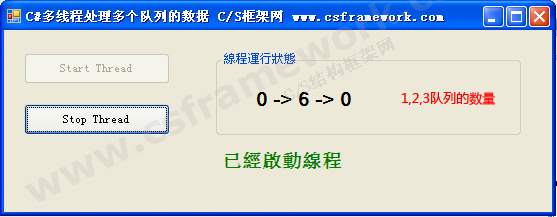|
C#多线程处理多个队列的数据(交叉线程访问及Invoke方法使用)
C#多线程处理多个队列的数据
public static void Testing(Form sender, DelegateShowStateInfo method) { _StateMethod = method; _OwnerForm = sender; _Exit = false; ThreadPool.QueueUserWorkItem(MainTestThread); ThreadPool.QueueUserWorkItem(Queue1Thread); //啟動Queue1線程 ThreadPool.QueueUserWorkItem(Queue2Thread); //啟動Queue2線程 } // 来源:www.CSFramework.com, C/S结构框架学习网  using System; using System.Collections.Generic; using System.Linq; using System.Text; using System.Threading; using System.Collections; using System.Windows.Forms; // C/S框架网 www.csframework.com namespace ThredProcessQueue { //用于顯示狀態的代理方法類型定義 public delegate void DelegateShowStateInfo(string state); /// <summary> /// 測試器 /// </summary> public class QueueTester { private static bool _Exit = false; //標記是否已中斷測試程序 private static Form _OwnerForm; //測試的窗體 private static DelegateShowStateInfo _StateMethod; private static IList _Queue1 = new ArrayList(); //Queue1的數據 private static IList _Queue2 = new ArrayList(); //Queue2的數據 private static IList _Queue3 = new ArrayList(); //Queue3的數據 public static void StopThread() { _Exit = true; _OwnerForm = null; } public static void Testing(Form sender, DelegateShowStateInfo method) { _StateMethod = method; _OwnerForm = sender; _Exit = false; ThreadPool.QueueUserWorkItem(MainTestThread); ThreadPool.QueueUserWorkItem(Queue1Thread); //啟動Queue1線程 ThreadPool.QueueUserWorkItem(Queue2Thread); //啟動Queue2線程 } //測試用的主線程,循環向隊列1中壓入數據。 public static void MainTestThread(object state) { Random R = new Random(1); double V = 0; while (_Exit == false) { //在while(true)里一直对数据进行读取,然后放到queue1中, //与此同时如果queue1中有数据,则线程1就开启 //臨時數據,隨機數 V = R.NextDouble(); _Queue1.Add(V); //把數據插入到隊列1 Application.DoEvents(); ShowState(); Thread.Sleep(100);//生成隨機數太快,為了看清效果,暫停n毫秒 } } //对queue1中的数据进行处理,处理后放到queue2中 public static void Queue1Thread(object state) { while (_Exit == false) { while (_Queue1.Count > 0) { //对queue1中的数据进行处理,处理后放到queue2中 _Queue2.Add(_Queue1[0]); _Queue1.RemoveAt(0); Application.DoEvents(); ShowState(); } } } //对queue2中的数据进行处理,处理后放到queue3中 public static void Queue2Thread(object state) { while (_Exit == false) { while (_Queue2.Count > 0) { //对queue1中的数据进行处理,处理后放到queue2中 _Queue3.Add(_Queue2[0]); _Queue2.RemoveAt(0); Application.DoEvents(); ShowState(); } } } //用于監視各隊列狀態的線程 public static void ShowState() { string stateInfo = QueueTester._Queue1.Count.ToString() " -> " QueueTester._Queue2.Count.ToString() " -> " QueueTester._Queue3.Count.ToString(); try { if (_OwnerForm != null) { _OwnerForm.Invoke(_StateMethod, stateInfo); Application.DoEvents(); } } catch { } } } } // 来源:www.CSFramework.com, C/S结构框架学习网
参考文档:
框架能否支持同时访问多个数据源? C#.Net C/S结构开发框架中数据访问层(DAL)的作用 C# 使用设计模式构建通用数据库访问类 C#SQL客户端处理大文本数据通用接口 C#,Asp.Net多线程断点续传下载 C#数据访问层主类.(SqlHelper)SQLDataAccess.cs C#.NET SQL数据库备份与还原解决方案 开发框架处理保存图片数据 C# C/S架构下客户、供应商等大批量数据单条记录选取组件 C#.NET 处理字符串数据去左右空格、全角转半角 C# 打开设为密码的Access MDB数据库 C#异步操作等待窗体,异步多线程处理数据通用界面(frmThreadOperating) C#多线程异步处理数据通用界面窗体(frmThreadOperating) C#.NET 处理SQL特殊数据类型Geography/Geometry/Hierarchyid/XML C# Winform 使用SUM CASE WHEN实现动态列交叉数据报表
其它资料:
什么是C/S结构? | C/S框架核心组成部分 | C/S框架-WebService部署图 | C/S框架-权限管理 | C/S结构系统框架 - 5.1旗舰版介绍 | C/S结构系统框架 - 功能介绍 | C/S结构系统框架 - 产品列表 | C/S结构系统框架 - 应用展示(图) | 三层体系架构详解 | C/S架构轻量级快速开发框架 | C/S框架网客户案例 | WebApi快速开发框架 | C/S框架代码生成器 | 用户授权注册软件系统 | 版本自动升级软件 | 数据库底层应用框架 | CSFramework.CMS内容管理系统 | |
在线客服
 在线客服
在线客服






